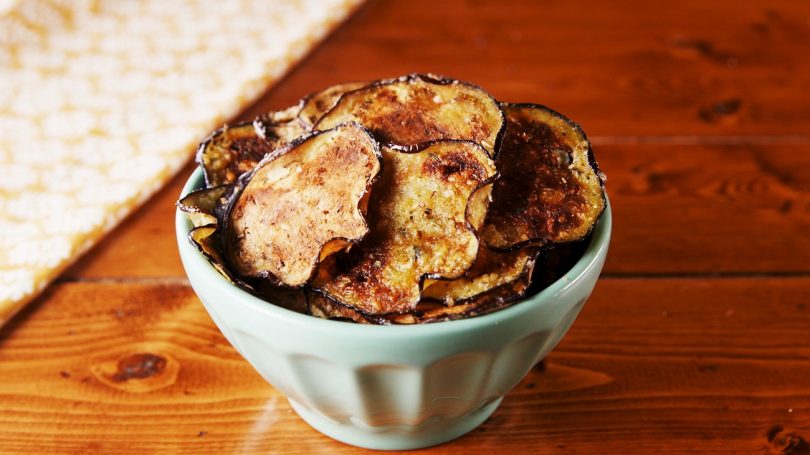Learn to dehydrate aubergines (eggplant) at home!
Aubergines belong to the nightshade family of plants, together with potatoes, tomatoes, and bell peppers. Like tomatoes, aubergines hang from a vine that grows at a height of several feet. The vegetable’s sponge-like cream-colored flesh is dotted with edible small seeds, and encased by a glossy deep purple skin.
Aside from the classic purple aubergine variety, the veggie is also available in other colors like jade green, lavender, yellow, and orange. It also comes in a variety of sizes and shapes, the most popular of which is the large, pear-shaped egg variant, appropriately known in America as eggplant.
Because of its bitter taste, aubergines were more known for centuries as decorative garden plants than as food. However, it has since grown in popularity as a table staple when the wild version from South East Asia spread to the world.
If you have an abundant stock of aubergines, it is best to dehydrate the excess to make them keep for a long time, allowing you to have some available anytime you need them.
How to Dehydrate Aubergines (Eggplant) at Home
The following are the methods for drying aubergines.
Drying aubergines in the food dehydrator
Select fresh and firm aubergines as these will better preserve than wrinkled or deteriorating ones.
- Slice the aubergines into 1” pieces. Make sure not to wait too long as the flesh will quickly discolor.
- Steam blanch the aubergines for around 3 minutes or boil for 1 minute to help the veggie keep its color when dehydrated. Put the aubergine slices in cold water to stop them from cooking.
- Line up the veggie slices in the dehydrator tray, allowing some breathing room between the pieces.
- Set the dehydrator temperature to around 140F.
- Dry for a few hours or until completely dry. Check for dryness every hour.
Once completely dry, let them cool and store the dried aubergines in airtight containers. (More on this in a later section.)
SEE ALSO: A Guide for Beginners: How to Dehydrate Food with a Dehydrator
Sun-drying aubergines
Select fresh and firm aubergines as these will better preserve than wrinkled or deteriorating ones.
- Slice the aubergines into 1” pieces. Make sure not to wait too long as the flesh will quickly discolor.
- Steam blanch the aubergines for around 3 minutes or boil for 1 minute to help the veggie keep its color when dehydrated. Put the aubergine slices in cold water to stop them from cooking.
- Line the pieces on a sheet of baking paper, making sure they are not touching one another.
- Leave the baking paper sheets under the sun (could be in your porch, balcony, or garden table). Make sure to keep the veggies safe from animals and the wind.
- Check daily for the desired texture and dryness. You want them completely dry. It may take at least 2 days to completely dry the aubergines.
Once completely dry, store the dried aubergines in airtight containers.
Drying aubergines in the oven
Repeat steps 1 to 5 of the previously discussed method.
- Line the aubergine slices in a baking sheet, with a little breathing room between slices.
- Set the oven temperature to 122F.
- Allow dehydrating for 6 to 8 hours, checking for dryness hourly after the 4th hour. You can leave the oven door slightly open for better air circulation.
- Once done dehydrating, take the veggies out of the oven, and allow to cool down at room temperature.
Store the dried aubergines in airtight containers.
Storing Dried Aubergines
Proper storage will allow you to keep your dried aubergines for as long as a full year, even without refrigerating or freezing.
- Place the dried aubergines in airtight, sealed containers or glass jars. Jars are typically preferred for keeping dried veggies than plastic bags. For one, if the bag has even a pinhole leak, or if you don’t completely seal the bag, your food will deteriorate at a steady pace.
- Keep the containers in a clean, cool, and dark place. Avoid placing the containers under direct sunlight or near a heat source.
- You can freeze the dried aubergines.
SEE ALSO: How to Store Dried Vegetables – Methods, Pros, and Cons
Benefits of Dried Aubergines
Following are proven benefits of including (dried) aubergines in your regular diet
1. Dried aubergines are a generous source of minerals and vitamins
Aubergines contain vitamins C, K, and B6, as well as niacin, thiamine, manganese, magnesium, copper, phosphorous, fiber, potassium, and folic acid, among others.
2. Aubergines help with digestion
Fiber is important in maintaining a balanced diet, which helps improve gastrointestinal health.
3. Dried aubergines help promote heart health
Aubergines’ fiber content not only helps in proper digestion. It is also good for the heart as it reduces cholesterol in the body.
4. It may help to prevent cancer
The vegetable contains manganese, a natural antioxidant. Antioxidants are the body’s best defense against serious ailments like cancer.
5. Aubergines help improve bone health
The veggie isn’t only nice to look at. Its natural compounds are linked to stronger bones, reduced osteoporosis, and increased bone density.
6. It may help to prevent anemia
Lack of iron in the body may result in anemia. Aubergines are rich sources of iron that can help fight anemia.
7. Dried aubergines help improve brain function
Aubergines contain phytonutrients, natural chemicals that have been linked to improved mental health. This is achieved through better blood flow in the body as well as into the brain.
Preparing Your Dried Aubergines for Cooking
When you need to use your dried aubergines, just rehydrate some. Boil a cup of boiling water (or just enough to cover the veggies you are rehydrating), then pour over the dried veggies. Set aside for at least 30 to 45 minutes to allow the veggies to rehydrate well. Make sure to rehydrate only what you need.
Notice that the dried aubergines will not soak up as much water it originally had when fresh, but they will rehydrate enough to be used satisfactorily in your recipes.
LEARN ALSO: Eggplant Parm Chips
Aubergines discolor and deteriorate quickly when fresh. One of the best ways to preserve the shelf life of your excess stock of aubergines is to dehydrate them. This way, you will have a ready supply of the veggie any time of the year!





